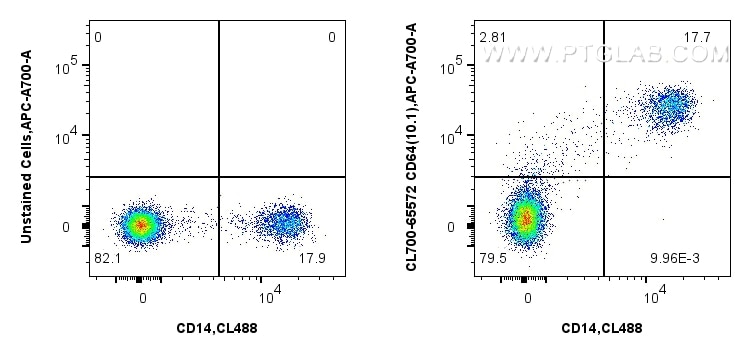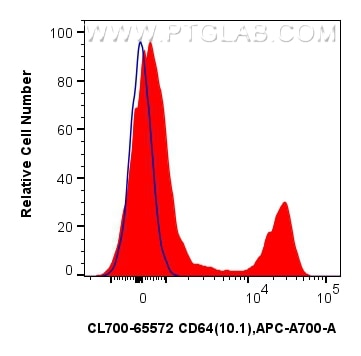CD64 Rekombinanter Antikörper
CD64 Rekombinant Antikörper für FC
Wirt / Isotyp
Maus / IgG2a
Getestete Reaktivität
human
Anwendung
FC
Konjugation
CoraLite®700 Fluorescent Dye
CloneNo.
10.1
Kat-Nr. : CL700-65572
Synonyme
Geprüfte Anwendungen
| Erfolgreiche Detektion in FC | humane PBMCs |
Empfohlene Verdünnung
| Anwendung | Verdünnung |
|---|---|
| This reagent has been pre-titrated and tested for flow cytometric analysis. The suggested use of this reagent is 5 ul per 10^6 cells in a 100 µl suspension or 5 ul per 100 µl of whole blood. | |
| Sample-dependent, check data in validation data gallery | |
Produktinformation
CL700-65572 bindet in FC CD64 und zeigt Reaktivität mit human
| Getestete Reaktivität | human |
| Wirt / Isotyp | Maus / IgG2a |
| Klonalität | Rekombinant |
| Typ | Antikörper |
| Immunogen | Human rheumatoid synovial fluid cells and fibronectin-purified monocytes. |
| Vollständiger Name | Fc fragment of IgG, high affinity Ia, receptor (CD64) |
| Berechnetes Molekulargewicht | 374 aa, 43 kDa |
| GenBank-Zugangsnummer | BC032634 |
| Gene symbol | FCGR1A |
| Gene ID (NCBI) | 2209 |
| Konjugation | CoraLite®700 Fluorescent Dye |
| Excitation/Emission maxima wavelengths | 702 nm / 723 nm |
| Form | Liquid |
| Reinigungsmethode | Protein-A-Reinigung |
| Lagerungspuffer | PBS with 0.09% sodium azide and 0.5% BSA |
| Lagerungsbedingungen | Store at 2-8°C. Avoid exposure to light. Stable for one year after shipment. |
Hintergrundinformationen
Fcγ receptor comprise a multigene family of integral membrane glycoproteins that exhibit complex activation or inhibitory effects on cell functions after aggregation by complexed immunoglobulin G (IgG) (PMID: 17005690 ). CD64, also known as FcγRIA, is a high-affinity receptor for the Fc region of IgG. It is expressed by monocytes/macrophages, activated neutrophils, dendritic cells, and early myeloid cells (PMID: 23293080; 19642859; 7680917). CD64 functions in both innate and adaptive immune responses.
Protokolle
| PRODUKTSPEZIFISCHE PROTOKOLLE | |
|---|---|
| FC protocol for CL700 CD64 antibody CL700-65572 | Download protocol |
| STANDARD-PROTOKOLLE | |
|---|---|
| Klicken Sie hier, um unsere Standardprotokolle anzuzeigen |



